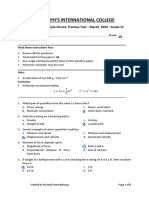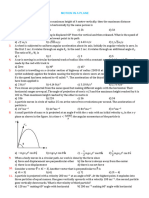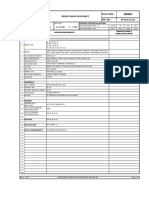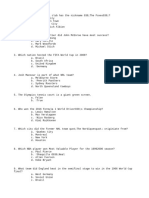PHYSICS — Q.1 to Q.
45
1. The dimensional formula of Planck’s constant (h) is: 2. If the errors in measurement of mass and length are 2% and
a) [ML2T−1] b) [ML2T−2] c) [MLT−2] d) [M0L2T−1] 1% respectively, the maximum percentage error in density of a
uniform wire is:
a) 1% b) 2% c) 3% d) 4%
3. The value of g is determined by measuring length (l) and 4. A car moving in a straight line has velocity v = (6 + 0.5t) m/s.
time period (T) of a simple pendulum using g = 4π2l/T2. If ∆l/l = Its displacement in first 8 s is:
0.5% and ∆T/T = 1%, then percentage error in g is: a) 48 m b) 64 m c) 80 m d) 88 m
a) 1% b) 1.5% c) 2% d) 2.5%
5. A particle starts from rest and moves with constant 6. The velocity–time graph of a particle is a straight line with
acceleration a. The ratio of distances covered in the 3rd and negative slope intersecting time axis at t = 10 s. If initial velocity
4th seconds is: is 20 m/s, the uniform acceleration is:
a) 7:9 b) 5:7 c) 9:7 d) 1:1 a) −1 m/s2 b) −2 m/s2 c) −0.5 m/s2 d) −4 m/s2
7. A ball is thrown vertically upward with speed u. The ratio of 8. Two trains each moving at 36 km/h approach each other on
time of ascent to time of descent (neglecting air resistance) the same track. A bird flies to and fro between them with speed
when thrown from and caught at the same level is: 18 m/s until they collide. If at t = 0 the trains are 1.8 km apart,
a) 1:2 b) 2:1 c) 1:1 d) Depends on u total distance flown by the bird is:
a) 900 m b) 1200 m c) 1350 m d) 1800 m
9. A projectile is fired with speed 40 m/s at 30° to horizontal. 10. For a given projectile, if angle of projection is θ and (90°−θ),
Range (on level ground) is: the ratio of maximum heights is:
a) 80√3 m b) 40√3 m c) 200 m d) 400/√3 m a) tan2θ b) 1 c) cot2θ d) sin2θ
11. A particle moves in a circle of radius R with uniform speed 12. The x and y components of a vector are 3 and 4
v. Its acceleration has magnitude: respectively. The angle it makes with the x-axis is:
a) v/R b) v2/R c) v2/R2 d) R/v2 a) 30° b) 36.9° c) 45° d) 53.1°
13. The relative velocity of A w.r.t B is zero. It implies: 14. A block of mass 5 kg is on a horizontal surface (µ = 0.2). A
a) A and B are at rest b) A and B have same velocity c) A is force of 20 N is applied. The acceleration is (g = 10 m/s2):
accelerating d) B is accelerating a) 0 m/s2 b) 1 m/s2 c) 2 m/s2 d) 3 m/s2
15. A 2 kg block is suspended by a light string from the ceiling 16. A body of mass m moving with velocity v hits a wall and
of a lift moving upward with acceleration 2 m/s2. Tension in the rebounds with the same speed in opposite direction. Impulse
string is (g = 10 m/s2): delivered to the body is:
a) 16 N b) 20 N c) 24 N d) 28 N a) 0 b) mv c) 2mv d) −2mv
17. A block of mass 4 kg on a rough incline (θ = 30°, µ = 0.3) is 18. A 1 kg object is moving in a circle of radius 2 m with
just prevented from sliding down by a force applied parallel to angular speed 5 rad/s. The net force on it is:
the plane upward. The minimum force required is (g = 10 m/s2): a) 10 N b) 25 N c) 50 N d) 100 N
a) 0 N b) 2 N c) 4 N d) 6 N
19. A ball of mass 0.2 kg moving at 10 m/s collides elastically 20. A 10 kg block is pushed against a wall with a horizontal
head-on with a stationary ball of mass 0.3 kg. Speed of 0.2 kg force of 100 N. If µs = 0.4 and g = 10 m/s2, frictional force on
ball after collision is: the block is:
a) 2 m/s b) 4 m/s c) −2 m/s d) −4 m/s a) 0 N b) 40 N (up) c) 40 N (down) d) 100 N (up)
21. A rocket ejects gas at high speed. The principle involved is: 22. Two forces 3 N and 4 N act at right angles. The magnitude
a) Newton’s I law b) Newton’s II law c) Newton’s III law d) of their resultant is:
Work–energy theorem a) 1 N b) 5 N c) 7 N d) √7 N
23. In projectile motion, time of flight is doubled when: 24. A body is moving in a straight line with variable acceleration
a) u is doubled keeping θ same b) θ is doubled c) sinθ is a = 6t. If v = 0 at t = 0, then v at t = 2 s is:
doubled d) g is doubled a) 6 m/s b) 8 m/s c) 10 m/s d) 12 m/s
25. The unit of coefficient of friction is: 26. A person throws a ball horizontally with speed 10 m/s from
a) N b) N/m c) Dimensionless d) kg·m/s a 20 m high cliff. Neglect air resistance. The horizontal range is
(g = 10 m/s2):
a) 10 m b) 20 m c) √40 m d) 20√2 m
27. A block slides down a rough plane at constant speed. The 28. For two vectors A and B, |A + B| = |A − B|. Then the angle
angle of inclination is 30°. The coefficient of kinetic friction is: between A and B is:
a) 0.173 b) 0.5 c) 0.577 d) 1.732 a) 0° b) 60° c) 90° d) 120°
29. The unit of impulse is equivalent to: 30. A cricket ball of mass 0.16 kg is hit by a bat so that its
a) N·m b) kg·m/s c) N/m d) W·s velocity changes from −10 m/s to +20 m/s in 0.01 s. Average
force on the ball is:
a) 160 N b) 320 N c) 480 N d) 800 N
�31. A resultant of two forces is maximum when the angle 32. A block of mass m is placed on a smooth wedge of angle θ
between them is: which is accelerating horizontally with acceleration a. The
a) 0° b) 90° c) 120° d) 180° normal reaction on the block is:
a) mg cosθ b) m(g + a sinθ) c) m(g cosθ + a sinθ) d) m(g
sinθ + a cosθ)
33. A car of mass 1000 kg negotiates a flat curve of radius 50 34. The position of a particle varies as x = 2t3 − 3t2 + 4 (SI).
m at 10 m/s. Minimum coefficient of friction needed is: The acceleration at t = 2 s is:
a) 0.1 b) 0.2 c) 0.5 d) 1.0 a) 6 m/s2 b) 12 m/s2 c) 18 m/s2 d) 24 m/s2
35. A rubber ball dropped from height H rebounds to height 36. If a force F acts on masses m and 2m producing
H/4. The coefficient of restitution is: accelerations a and b respectively, then a:b is:
a) 1/2 b) 1/4 c) 1/√2 d) √(1/4) a) 1:1 b) 1:2 c) 2:1 d) 4:1
37. A vector has magnitude 10 and makes 60° with x-axis in 38. A lift is moving downwards with constant acceleration 2
the x–y plane. Its y-component is: m/s2. The apparent weight of a 50 kg person is (g = 10 m/s2):
a) 5 b) 5√3 c) 10√3/2 d) 10/2 a) 600 N b) 500 N c) 400 N d) 300 N
39. A stone is projected so that the ratio of its maximum height 40. The magnitude of pseudo force on a mass m in a frame
to the square of time of flight is constant. Then the initial speed accelerating with a is:
is proportional to: a) ma opposite to a b) ma along a c) mg downward d)
a) sinθ b) cosθ c) tanθ d) secθ zero
41. The line of action of which force always passes through the 42. A cyclist turns a flat curve of radius R at speed v. If µ is
centre of mass of a system? coefficient of friction between tyres and road, condition to avoid
a) Internal forces b) External forces c) Constraint forces skidding is:
d) Non-conservative forces a) v2 < µgR b) v < µgR c) v < µR/g d) v2 < gR/µ
43. A body of mass m is dropped from a height h. Neglect air 44. A block of mass m rests on a rough horizontal surface. A
resistance. The impulse delivered by gravity during fall is: force F is applied at an angle θ above the horizontal. The
a) m√(2gh) b) mgh c) 2mgh d) Not defined minimum F to just start motion is:
a) µmg/(cosθ − µ sinθ) b) µmg/(cosθ + µ sinθ) c) µmg(cosθ
− µ sinθ) d) mg(cosθ − µ sinθ)
45. Two particles are projected with same speed u at angles θ
and 90°−θ. The ratio of their times of flight is:
a) 1 b) tanθ c) cotθ d) secθ



























































































